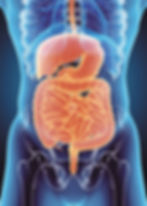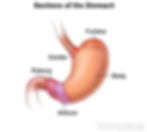Digestive Health: Understanding The Second and Third Phases of Digestion
- Karen Haralson
- Jun 7, 2023
- 6 min read
Updated: Jun 12, 2023
The digestive system breaks down food into its building blocks for absorption and then eliminates the waste. This process is called digestion.

Digestion is vitally important in obtaining energy, repairing tissues, and growing. To use our food the digestive system uses chemical, biological, and mechanical processes along with nerve impulses so that we can use our food.
Within each phase, the processes are different according to where digestion takes place:
1. Cephalic (head) phase – the sensory organs (taste, smell, etc.) and mouth.
2. Esophageal phase – the esophagus.
3. Gastric phase – the stomach.
4. Intestinal phase – the small and large intestines.
This article goes into a quick review of the cephalic phase of digestion before delving into the esophageal and gastric phases. You will also find helpful tips to support digestion wellness and decrease digestion symptoms you may be having.
Understanding how the digestive system functions is vital to optimizing your long-term health.
A Review of the Cephalic Phase
The cephalic phase of digestion, discussed in this article here, is how we mobilize the stomach, taking the body out of rest and preparing it to digest. Our sensory organs, including the nose, ears, eyes, and sensations of touch, help to stimulate stomach movement as well as secrete saliva and stomach acid. Chewing our food thoroughly assists in food movement through the digestive system, saving energy during later breakdown phases and nutrient absorption.
Tips on improving the first phase of digestion include:
· Slowing down to allowing the senses to stimulate the digestive system, and
· Chewing food thoroughly as this has effects throughout the body.

After swallowing, the cephalic phase ends, and food moves into the esophagus.
The Esophagus Keeps Digestion Moving
During the esophageal phase, the esophagus transports food and liquid through its hollow and muscular tube, starting from the mouth and ending in the stomach. Involuntary muscular contractions, called peristalsis, begin at the top of the esophagus and continue throughout the digestive system to keep swallowed substances moving.
Food then moves into the stomach through a flap of tissue at the base of the esophagus. This flap, called the lower esophageal sphincter, or LES, helps to protect our esophageal muscle lining from damage that harsh stomach acids can cause.
Through swallowing, the LES is triggered to open when you swallow and close after food moves into the stomach. If the LES opens during digestion, food and stomach acid can back flow into the esophagus, giving you heartburn symptoms. Over time, repeated exposure to these harsh acids becomes a risk for severe reflux, GERD, and hiatal hernias.
Packing a Powerful Punch to Proteins
The stomach, where the gastric phase takes place, is a J-shaped, mucous-lined, and muscular pouch. This powerful organ is designed to stretch, hold, contract, and produce strong stomach acids and digestive enzymes. Before we start eating, the brain signals the stomach to begin secreting acid for chemical breakdown and moving muscles for mechanical breakdown.
The stomach primarily breaks down protein into smaller components called amino acids, found in foods such as meat, eggs, and nuts. Fats and carbohydrates begin their breakdown in the mouth and are less so broken down in the stomach. Fats and carbohydrates are found in avocados, carrots, and grains.
They are separated from proteins and move into the small intestine for breakdown. The stomach absorbs few nutrients; most absorption occurs in the small intestine.

Digestive Acids, Enzymes, and Squeezing
Stomach acid is powerful on the pH scale and has a pH of 2. For reference, lemon juice and vinegar are slightly less acidic, having a pH of 3. The stomach's pH, or acid-base balance, is diluted when food enters, triggering acid production for an hour and a half. Stomach acid has important jobs: protein breakdown, destroying bacteria, and activating digestive enzymes.
The digestive system makes digestive enzymes which help speed up the process of chemical reactions. Pepsin, trypsin, and peptidase are enzymes found in the stomach to help break down protein. Gastric lipase is an enzyme found in the stomach that helps break down a type of fat called triglycerides.
The combination of robust squeezing, stomach acid, and digestive enzymes breaks down the food into smaller particles, eventually turning it into a liquid substance called chyme. Chyme can easily pass into the small intestine. Another tissue flap, the pyloric sphincter, releases chyme into the small intestine. It also serves to prevent chyme from reentering the stomach.
Problems can arise in the body within any of these complex gastric phase processes. Too much or too little acid, squeezing, or breakdown are all problems that can occur, making it difficult to get optimal nutrient absorption. And without the right kind or amounts of nutrients, we can have problems anywhere in the body that requires energy, repair, or growth. This is why optimizing digestion can significantly affect the whole body!
Vagus Nerve: Gut-Brain Connection
We can’t leave out the nervous system, specifically the vagus nerve, which helps make up the gut-brain connection. The vagus nerve receives and sends signals to and from the brain, telling the stomach when to contract. Problems with the vagus nerve can cause a slow stomach emptying, a condition called gastroparesis.
There is evidence that the vagus nerve plays a role in appetite, emotions, and even the immune system as it relates to the digestive system. Relaxation techniques such as meditation, breathing, and yoga help stimulate the vagus nerve and can play a role in improving problems with nutrient absorption.

Support for Digestion System Wellness
There are ways we can eat and lifestyle factors that will help support our esophageal and gastric phases of digestion. When they are not functioning well, we may notice symptoms such as:
· Changes in our gut bacteria leading to intestinal infections,
· Gas, burping, bloating, or diarrhea related to low stomach acid or overeating, and
· Fatigue from poor absorption of vitamins and minerals such as iron and vitamin B12.
Bleeding, nausea, vomiting, constipation, and pain are other symptoms that may be preventable using the tips below. If you experience any of these symptoms, check with your doctor. There could be a serious underlying condition that requires the advice of a medical professional.
Helpful Tips for Digestive Health
· Eat until you’re full but avoid overeating. The stomach can stretch but overeating, over time, leads to problems. Overeating causes tiredness as the body uses increased energy to break down excess food. The excess food puts more pressure on the stomach walls and may cause acid reflux, occurring when highly acidic stomach acid enters the esophagus. Long-term, repeated overeating also causes hormone imbalances, as in insulin and leptin, causing concern for diabetes and weight gain.
· Keep the LES strong. Certain drinks and foods can weaken the LES over time. These include too much coffee, chocolate, alcohol, sugar-sweetened and processed foods.
· Lifestyle changes. Drinking alcohol causes changes in the stomach lining, making it susceptible to inflammation. In one study, over 70% of the control group, people who rarely drink alcohol, experienced inflammatory changes. Repeated over time, inflammation contributes to conditions such as gastritis and ulcers, which can cause bleeding and cancer.
· Quit the smoking habit. Smoking and vaping, which is the use of e-cigarettes, can cause ulcers and cancers in the stomach.
· Digest before going to bed. Eating meals just before bedtime also contributes to acid reflux. Waiting 2-3 hours before bed after eating is recommended.
Takeaway Tips
The esophageal and gastric phases of digestion are each unique and essential to the complex processes involved in digestive system function. While the esophagus transports food from the mouth to the stomach and the LES prevents acid-causing damage, the stomach is designed to hold these strong acids. It uses chemical, mechanical, and vagus nerve stimulation to break down food.
Digestive health tips include eating until you’re full and not overeating. Try limiting food and drink that weaken the LES helps prevent heartburn. Alcohol and smoking can irritate the stomach lining; avoiding these substances can prevent digestive symptoms from occurring.
Taking care of your digestive health is an excellent step to enjoying a healthy life. If you have any severe digestive system symptoms or symptoms that do not go away, get advice from a medical doctor.
Taking steps to support your digestion system function encourages better nutrient absorption. In the long run, this makes it easier for your body to repair tissues, grow new ones, and give you the energy you need daily.
***
Robin Fillner, RN, BSN, is a health writer, oncology nurse, and Certified Functional Nutrition Counselor. She is passionate about health and wellness. When she’s not writing or nursing, find her cooking something deliciously healthy or wildly adventuring. Find her at www.linkedin.com/in/robinfillner
